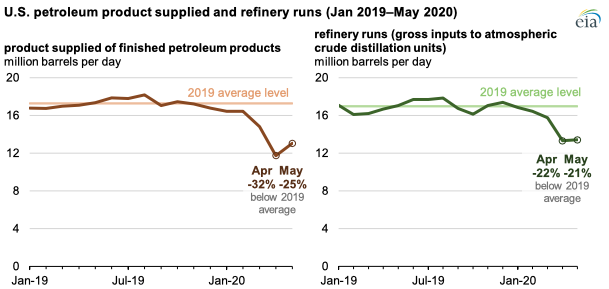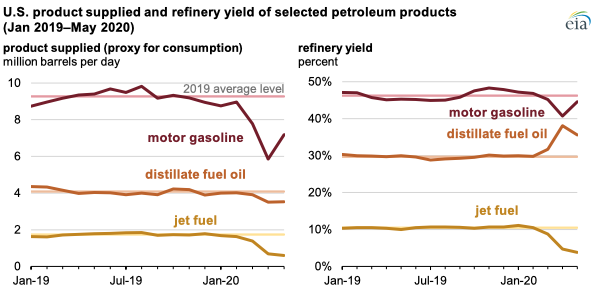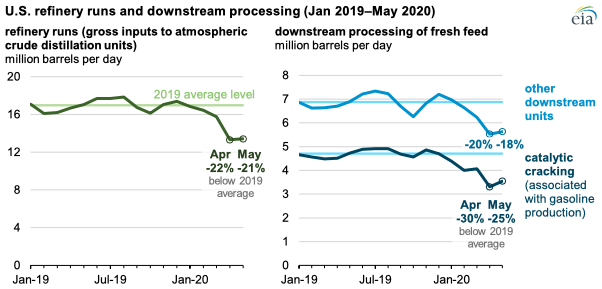Demand for transportation fuels in the United States has fallen since mid-March because of the spread of coronavirus and efforts to mitigate it. Demand for motor gasoline and jet fuel in particular has fallen to its lowest levels in years. In response, U.S. refineries reduced their operations to adjust to changing levels of overall demand for petroleum products and made other changes that resulted in proportionately less production of motor gasoline and jet fuel and more production of distillate fuel oil.

Beginning in April, refiners responded to less demand for transportation fuels by decreasing overall refinery runs. Refinery runs were 22% lower in April 2020 compared with the full year 2019 average of 17.0 million barrels per day (b/d). In May, inputs to distillation units were similar, at 21% lower than the 2019 average. These reductions largely resembled the overall declines in demand for finished petroleum products in those months, as measured by product supplied.
Because demand for motor gasoline and jet fuel was disproportionately affected by travel restrictions and other measures that were in place throughout much of the United States starting in late March, refineries changed operations in ways that resulted in less production of motor gasoline and jet fuel and more production of distillate fuel oil.

These three products generally have the highest yield percentages from refineries. In 2019, refinery yields for motor gasoline averaged 46%; distillate fuel oil, 30%; and jet fuel, 10%. Refinery yields reflect the volumetric ratio of a finished product to refineries’ total inputs of crude oil and net inputs of unfinished oils.
In April, refinery yields for motor gasoline fell to 41%, and jet fuel yields fell to 5%. Both values were, at the time, the lowest in the U.S. Energy Information Administration’s (EIA) monthly data series for refinery yields, which dates back to 1993. Refinery yields are zero-sum, meaning a decline in one product’s yield will mean an increase in another product’s or group of products’ yields.

In April, U.S. distillate fuel oil yields increased to 38%, their highest value on record. In the U.S. Gulf Coast region, distillate fuel oil yields surpassed those of gasoline for the first time, reaching 40% for distillate and 39% for gasoline. In May, as travel increased, motor gasoline demand increased, but jet fuel demand continued to fall.
Refineries can change their petroleum product output by running downstream units, or units that process the output from distillation units, differently. EIA surveys the amount of material (referred to as fresh feed) that runs through four types of downstream units (catalytic reformers, catalytic crackers, catalytic hydrocrackers and cokers). Of these four types, catalytic crackers tend to be associated with motor gasoline production, and these units were operated less than other downstream units in April.
The amount of fresh feed processed through catalytic crackers in April 2020 was 30% lower than its 2019 average of 4.7 million b/d. The amount of fresh feed processed through all other downstream units (reformers, hydrocrackers, and cokers) was 20% lower than the collective average of 6.9 million b/d in 2019.
Principal contributors: Peter Colletti, Corrina Ricker

Follow us on social media: